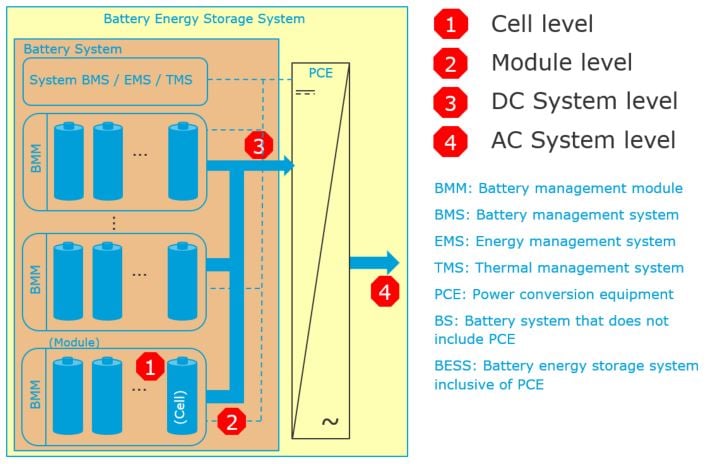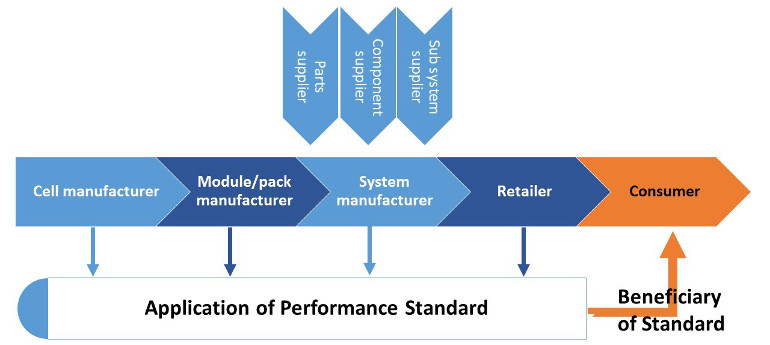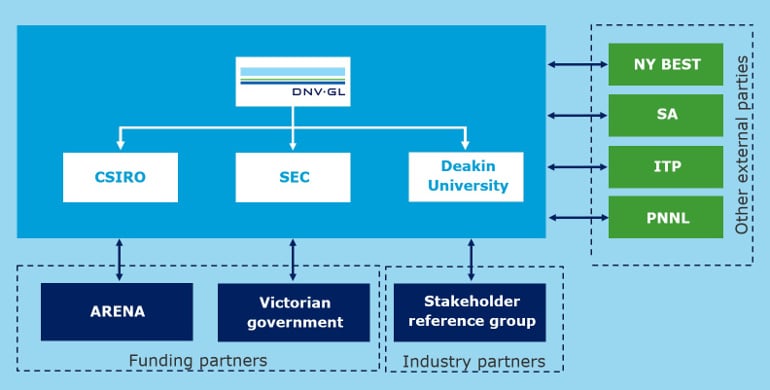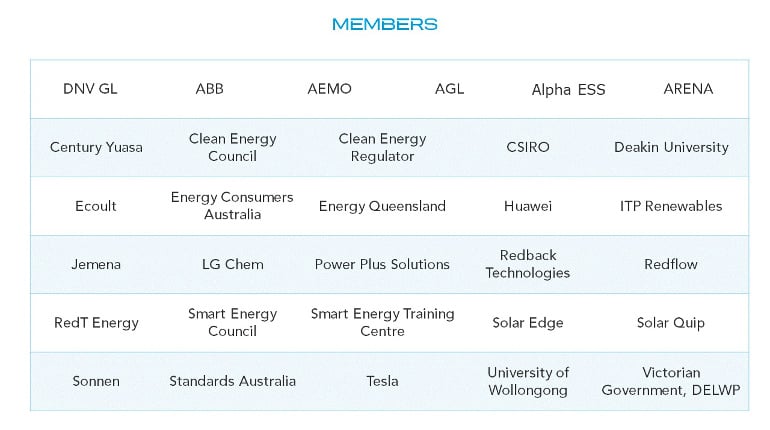Australian Battery Performance Testing Standard Project (ABPS Project)
Development of a proposed performance standard for a battery storage system connected to a domestic/small commercial solar PV system
Objective
The objective of this ARENA and Victorian Government co-funded project is to produce a draft Performance Standard (Draft Standard), for Battery Energy Storage Systems (BESS) connected to domestic/small commercial PV systems. The Draft Standard shall comprise a series of performance testing protocols & performance-metric reporting methods for manufacturers and system integrators.
This is to ensure that end users are better informed regarding the expected performance of a BESS, in order to compare systems on a like-for-like basis.
Following its completion, the Draft Standard will be submitted to Standards Australia, to begin the process of making it a formal Australian Standard. In the interim, the project will develop a best practice guide to be used until Standards Australia completes its own standards development process.
Background information
Australia has one of the highest proportions of households with PV solar systems installed in the world. With relatively high retail electricity prices, comparatively low feed-in tariff rates for exported PV energy generation and the rapid reduction in energy storage costs, the market for behind-the-meter battery systems has the potential to increase dramatically.
Two critical aspects for battery systems are safety and performance. At present, there is limited information available to allow end-users to make informed choices regarding the performance of battery systems.
This project aims to provide a solution through the development of an Australian Battery Performance Standard, under which battery performance can be tested and clearly articulated, thus providing improved consumer and industry confidence.
There are many different types of battery energy storage systems available today, however the majority are typically made up of multiple cells. These cells are generally grouped together into modules, which may have a battery management module monitoring them. Modules are then grouped together into a battery system, which will also have an overarching battery management system, typically a thermal management system and other auxiliary systems.
The following diagram illustrates the definitions used throughout this project of the various levels of a battery energy storage system.

Project timeline and outcomes
The ABPS project is a two-year project that kicked off in June 2018. To support the development of a draft Australian battery energy storage system (BESS) performance testing standard, the project has been divided into 2 main stages. The outputs of the stage 1 activities will provide input into the detailed activities to be undertaken in Stage 2.
Stage 1 consists of the following key activities:
- A comprehensive gap analysis on existing local and international battery energy storage performance standards
- The development of a proposed high-level Draft Standard
- Review and analysis of data and outputs from the related ARENA-funded IT Power (Australia) Pty Limited battery testing project
Stage 2 consists of the following key activities:
- Performance metrics development, and testing of commercial battery systems for optimization of the metrics
- Development of a battery capacity estimation methodology
- Development of a set of recommended criteria to select a battery management system (BMS)
- Identification of the performance hazards related to the operation of BESS
- Identification of the minimum set of information recommended to be included in material safety data sheets (MSDS)
Benefits
Manufacturers/Supply Chain - The Draft Standard shall provide recommended practices for the testing of battery energy storage system components and the associated reporting requirements to be provided to end-users by battery manufacturers and those who are involved in the BESS supply chain.
This should clarify requirements and enable the demonstration of product performance capabilities with respect to standardized practices and methodologies.
End-Users– Implementation of the Draft Standard should assist end-users to make informed choices regarding the performance of different BESS available in the market, in view of the intended application(s). Furthermore, it will provide confidence that performance metrics reported are relevant and are comparable between different manufacturer’s systems.
The following infographic provides an overview of the intended applicability of the Draft Standard, as well as the various parties typically involved in the manufacture and use of a battery energy storage system.

Project Structure
The project is made up of a consortium of entities, supported by a large stakeholder group as outlined in the following organogram. The role of each consortium partner is described following.

Consortium Partners
DNV
DNV is one of the world’s leading companies providing classification, technical assurance, software and independent expert advisory services, in addition to certification services to customers across a wide range of industries, including in energy storage. We provide energy advisory, testing, inspection and certification services globally. DNV representatives are active in IEC global standardisation activities (IEC TC-120) as well as national standardisation in many jurisdictions (E.g. US, UK and Europe). DNV also runs the BEST Test and Commercialisation Centre in the USA, a leading battery test facility with extensive battery performance test experience.
DNV initiated this project as it identified there is presently limited information available to allow end-users to make an informed decision regarding performance of battery energy storage systems in relation to payback period, reliability and lifetime.
DNV is the Project manager, leading the project consortium that includes CSIRO, Smart Energy Council and Deakin University.
CSIRO
CSIRO has a 30 year history in developing and evaluating battery and energy storage systems. CSIRO has extensive battery testing capability and know-how which will be leveraged to accomplish the goals of this project. New state-of-the-art laboratories, designed and dedicated specifically to investigate solar PV/renewable generation and energy storage technologies, will be devoted to this work.
CSIRO will predominantly be involved with the development of the performance metrics as well as the testing of various BESS to validate the performance metrics.
Smart Energy Council
The Smart Energy Council (SEC) is a national member based not-for-profit organisation and is governed by a volunteer board. They are funded by membership, industry events and training activities. The SEC represents companies including technology manufacturers, equipment providers, project developers, consultants, utilities and other energy industry leaders.
The Smart Energy Council is responsible for engaging with the industry throughout the project.
Deakin
Deakin University has a strong research focus in renewable energy and battery energy storage systems. The university has made significant investment to develop infrastructure and lab facilities for power and energy system research including renewables and energy storage systems.
Deakin will develop and validate the recommended battery capacity estimation methodology for the project.
Project funding partners
The project received funding from Australian Renewable Energy Agency (ARENA) as part of its Advancing Renewables Program and from the Victorian Government through the New Energy Jobs Fund (facilitated by the Department of Environment, Land, Water and Planning).
Stakeholder Engagement
Throughout the project period the consortium shall engage frequently and widely with the sector to ensure there is broad stakeholder consultation and feedback on the delivery of the Project and the development of the Project’s outcomes.
This shall include, but not be limited to, this website, liaison with a core Stakeholder Reference Group for the project, presentations at conferences, public webinars, media releases, invitation-only project workshops and journals articles.
Stakeholder Reference Group
A Stakeholder Reference Group (SRG) has been established for the Project to provide ongoing feedback. The SRG consists of a broad range of key stakeholders relevant to the development of the proposed Draft Standard including: battery manufacturers, industry associations, relevant government agencies/bodies, stakeholders representing end users, stakeholders with strong commercial battery experience, proponents of relevant existing battery storage projects, Standards Australia, the Victorian Government (DELWP) and ARENA.

